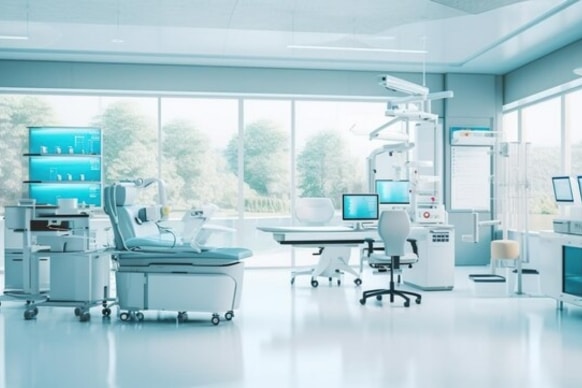
Simple Tips for Designing and Remodeling Medical Office Buildings
Creating a functional and aesthetically pleasing medical office building requires a deep understanding of both the healthcare industry and modern design principles. Medical offices must balance the needs of patients, staff, and practitioners while adhering to strict regulations and standards. Each decision, from the layout to the choice of materials, impacts the overall efficiency, safety, and comfort of the space.
A successful design starts with a thorough analysis of the specific requirements of the medical practices that will occupy the building. This involves considering patient flow, privacy needs, and the integration of technology. Moreover, the design should reflect the brand and values of the healthcare providers, creating an environment that is welcoming and professional.
The Role of Aesthetics in Medical Office Design
Aesthetics play a critical role in creating a welcoming and professional environment in a medical office. The design should reflect the identity of the medical practice while also promoting a sense of calm and comfort for patients.
Color schemes should be chosen with care, as they can influence mood and perception. Soft, neutral tones are often preferred in medical settings, as they create a sense of tranquility. However, pops of color can be used strategically to add interest and energy to the space.
Artwork and decor should be selected to enhance the overall aesthetic without overwhelming the space. Consider incorporating nature-inspired elements, such as plants or landscape artwork, to create a soothing environment.
Lighting is another important aspect of aesthetics. Natural light is ideal, as it creates a bright and welcoming atmosphere. Where natural light is not available, consider using soft, warm lighting to create a similar effect. Avoid harsh fluorescent lighting, which can make the space feel cold and clinical.
Collaborating with Medical Office Builders
Designing and remodeling medical office buildings is a complex process that requires the expertise of experienced professionals. Collaborating with medical office builders who understand the unique challenges of healthcare design can ensure that the project is completed on time, within budget, and to the highest standards.
Medical office builders bring valuable insights into the construction process, including knowledge of building codes, regulations, and best practices. They can also provide guidance on material selection, cost-saving strategies, and innovative design solutions.
Working closely with these professionals from the early stages of the project can help avoid costly mistakes and ensure that the final design meets the needs of all stakeholders. Regular communication and collaboration are key to a successful project.
Budgeting and Financing
One of the most challenging aspects of designing and remodeling a medical office building is managing the budget. Costs can quickly escalate if not carefully controlled, making it essential to establish a realistic budget from the outset.
Begin by identifying the most critical elements of the project and allocating funds accordingly. This might include investing in high-quality materials for high-traffic areas or incorporating advanced technology that will improve patient care.
It’s also important to factor in contingencies for unexpected expenses, such as delays or changes in scope. Working with a project manager who has experience in medical office construction can help keep the project on track and within budget.
Financing options should also be explored early in the process. This might involve securing loans, grants, or other funding sources to cover the cost of the project. Understanding the financial aspects of the project will help ensure that it is completed without compromising on quality.
Future-Proofing the Design
The healthcare industry is constantly evolving, with new technologies, treatments, and regulations emerging regularly. Future-proofing the design of a medical office building is essential to ensure that it remains functional and relevant for years to come.
This might involve designing flexible spaces that can be easily adapted to new uses or incorporating infrastructure that can support future technological advancements. Consider how the space might be used in the future and plan accordingly.
Investing in high-quality, durable materials and systems that can withstand the test of time is also important. While this might involve a higher initial investment, it can result in long-term savings by reducing the need for future renovations or repairs.
The Importance of a Well-Designed Exterior
The exterior of a medical office building is just as important as the interior. It is the first thing that patients and visitors see, and it sets the tone for the entire experience. A well-designed exterior should be both attractive and functional, providing a welcoming entrance and easy access.
Landscaping plays a crucial role in the overall aesthetic of the building. Well-maintained gardens, trees, and shrubs can create a calming environment and enhance the curb appeal of the property. Consider using native plants that require minimal maintenance and are suited to the local climate.
The entrance should be clearly marked and easily accessible, with ample parking for patients and staff. Consider incorporating covered walkways or canopies to protect visitors from the elements. Lighting is also important, both for safety and to create a welcoming atmosphere.
Prioritizing Privacy and Accessibility
Maintaining patient privacy is essential in medical office design. Ensure that exam rooms are strategically placed to minimize noise and provide a sense of confidentiality. Additionally, prioritize accessibility by incorporating features such as ramps, handrails, and spacious corridors to accommodate patients with mobility challenges.
Investing in Technology and Ergonomics
In today’s digital age, integrating technology into the design of a medical office building is crucial. Consider implementing features such as telemedicine stations, electronic health record systems, and patient portals to enhance efficiency and improve patient care. Furthermore, focus on ergonomics by choosing furniture and equipment that prioritize comfort and functionality for both patients and staff.
Designing a medical office building involves many factors to make it efficient and inviting. Maximize space, add natural elements, prioritize privacy and accessibility, and invest in technology and ergonomics. This creates a healing environment for patients. Trust The Modern Dentist – Homer Glen for expert guidance in building your ideal medical office.

